The ASUS ROG Strix B360-G Gaming Review: A Polarizing $100 Motherboard Design
by Joe Shields on September 25, 2018 8:00 AM EST- Posted in
- Motherboards
- Intel
- Asus
- MicroATX
- CrossFire
- M.2
- Coffee Lake
- i7-8700K
- B360
Visual Inspection
Our first close look at the board shows the MicroATX offering has quite a bit going on visually. All the stenciling spread across the length of the board is pretty hard to miss. We can see two large heatsinks as well as an IO cover which is a bit different from the B360 boards we have reviewed so far - up to this point other boards have eschewed large heatsinks, and focused on cost savings. To ASUS' credit the rear IO plate is also integrated giving the board a premium look on that front.
The PCB is black with all connectors coming in black as well. The primary PCIe slot is fortified to assist with large and heavy graphics cards. The ASUS ROG symbol graces the chipset heatsink. The stenciling using words/phrases doesn't really do much for the look of the board. I cannot say how it will be received by the public, but I know I would have preferred the board without that design for sure.
The ASUS B360-G Gaming also includes LEDs on the bottom part of the board and run along the left side close to the audio separation strip. The LEDs are RED in color and creates a nice theme matching glow from the bottom of the board. The colors are not able to be changed by the Aura software. That said, the board does include an RGB strip header which makes adding your own strip easy.
On the cooling side of things, the mATX board gives users a total of four 4-pin fan connectors located around the board. The CPU fan header is located above and to the right of the CPU socket next to the first DRAM slot. A chassis fan header, as well as an AIO_Pump connector, are located mid-board behind the audio stack on the left side of the board and above the primary PCIe slot. The last chassis fan header is located on the bottom of the board below the chipset. ASUS does not mention the output capabilities of these headers. The fans are able to be controlled through the BIOS and the AI Suite software with the ports support both PWM and DC control.
The power delivery section on the B360-G Gaming uses ASUS' Digi+ VRM which is likely based off of an International Rectifier part and controls the six phases we are able to see. The low and high side MOSFETs are On Semiconductor 4C06B and 4C10B ICs. This setup was plenty to keep a stock i7-8700K in check.
Swing around to the right side of the board, we can see the four single-sided locking DRAM slots and a full set of six SATA ports are all visible. Two of the SATA ports are mounted horizontally while the four others are oriented vertically. We are also able to see a USB 3.0 header, as well as the 24-pin ATX power lead for the board.
On the bottom half of the board, starting on the left side, we are able to see the Supreme FX audio chip which ASUS says has a better SNR than the Realtek ALC1220 codecs, is shielded and uses Nichicon audio caps. It also includes two onboard op amps for the front panel with a 32-600 Ohm range for headphones. It is nice to see premium audio used on a chipset designed to be more cost-effective than including higher-end features.
The middle is where we see the two M.2 slots (just above each full-length PCIe slot) as well as four PCIe slots. The first/top PCIe slot is fortified with ASUS' Safeslot to prevent shearing from heavy video cards and is the primary slot for the GPU. We can also see two x1 slots and the second full-length PCIe slot (runs at x4). The top slot is fed from the CPU while the x1 slots and bottom slot are fed from the chipset. This configuration allows for the board to support Crossfire setups, but not NVIDIA SLI.
| ASUS ROG Strix B360-G Gaming CPU PCIe Layout | ||
| 16-Lane Single |
16-Lane Dual |
|
| PCIe 1 | @x16 | @x16 |
| PCIe 4 (Chipset) |
- | @x4 |
| SLI | - | No |
| Crossfire | - | Yes |
Outside of that, we can see miscellaneous headers across the bottom. These range from front panel audio, USB 2.0 headers, as well as a chassis fan, and finally, the front panel header on the bottom right-hand corner.
The rear IO panel is pretty full featured for a B360 motherboard including USB 2.0, 3.0, and 3.1 (10 Gbps) ports on the back along with a full audio stack including an optical jack. Video output is handled by an HDMI port and DVI-D port. The board also includes a PS/2 port for legacy keyboard/mice as well as a single LAN port which includes ASUS' anti-surge guard to protect from ESD. The only core thing missing from the rear from a pricier system is a Type-C port.
- 1x PS/2 keyboard/mouse combo port
- 1 x DVI-D
- 1 x HDMI
- 2 x USB 3.1 (10 Gbps) Type-A ports
- 1 x Optical S/PDIF out
- 5 x Gold-plated audio jacks
- 2 x USB 3.0 ports (blue)
- 2 x USB 2.0 ports (black)
In the Box
ASUS includes the following:
The package includes everything a user needs to set the board up and running.
- User Manual
- Support DVD
- 2 x SATA cables
- 1 x M.2 screw
- 1 x Door hanger
- 1 x cable tie package
- 1 x ROG stickers


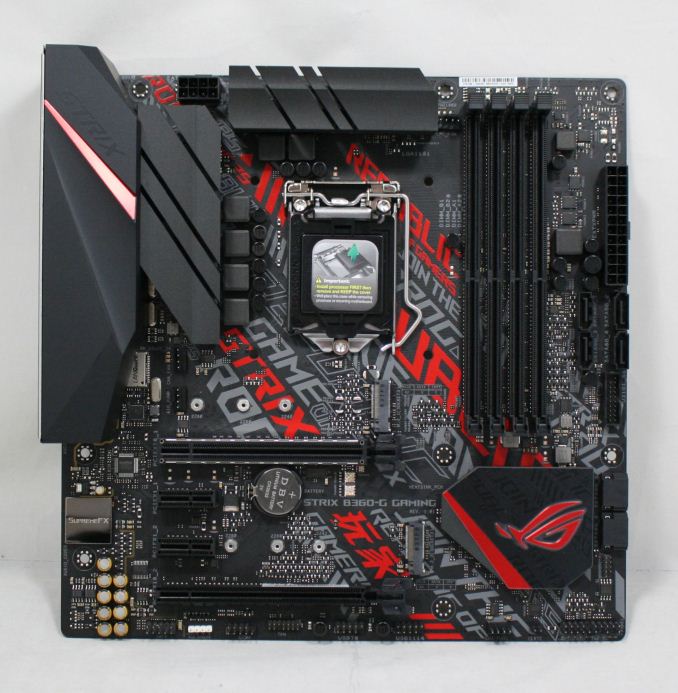
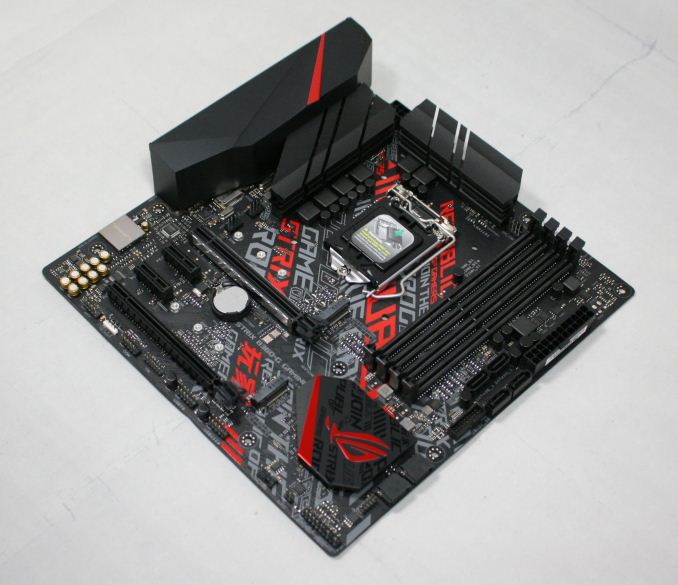
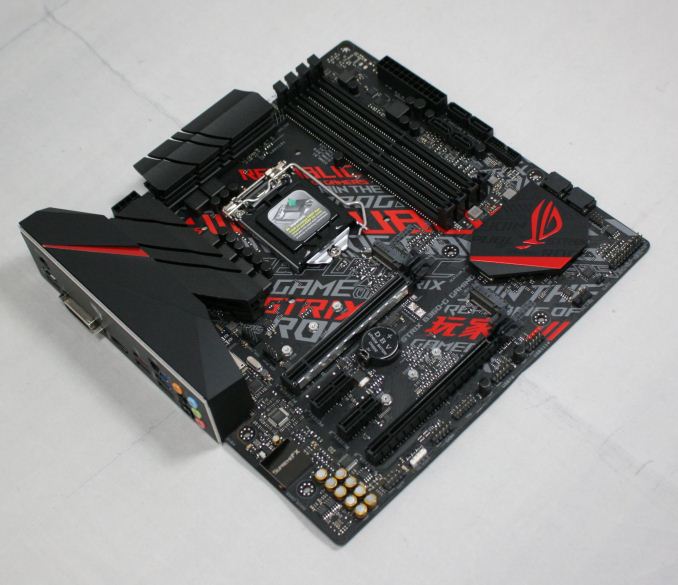
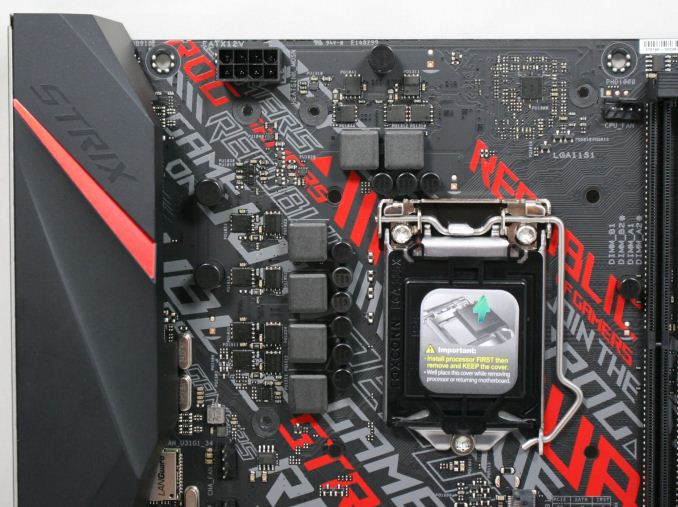
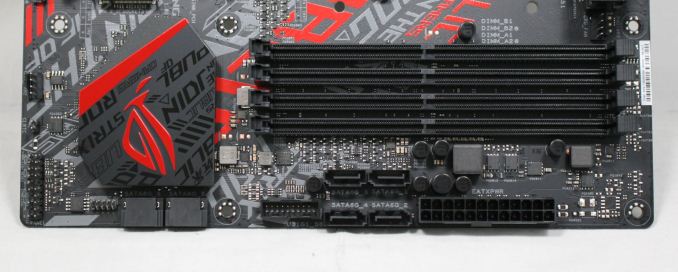
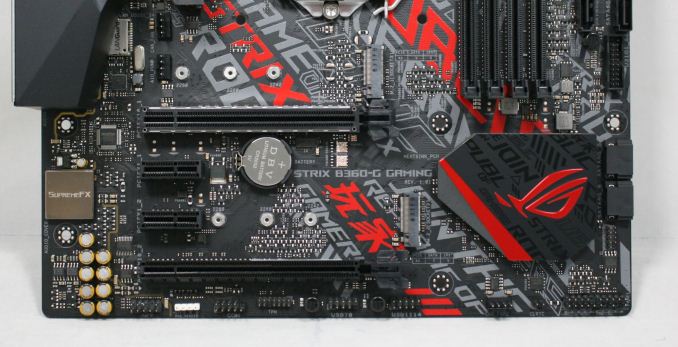
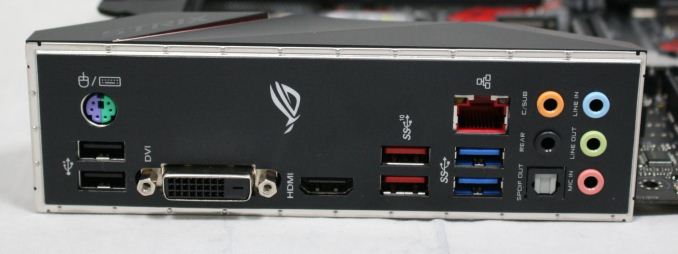
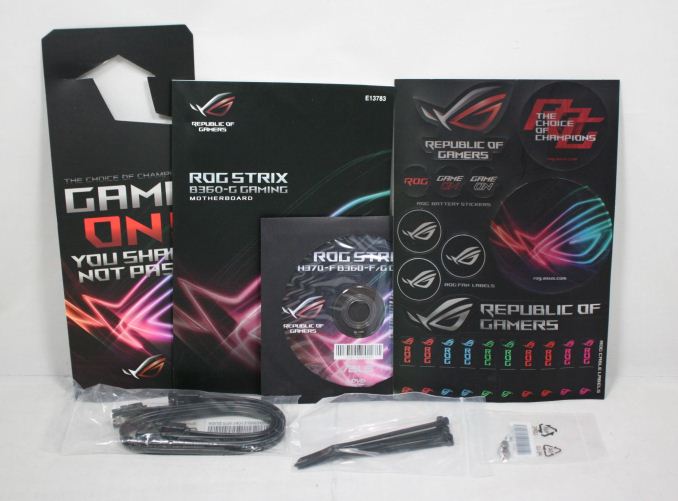














26 Comments
View All Comments
Inteli - Tuesday, September 25, 2018 - link
And I thought the B450-F was a bit gaudy...at least the stenciling wasn't red and white.Besides that, I like seeing feature-rich boards at this price point. High-end Z370/X470 boards are overkill for a lot of builders who aren't going to do much (if any) overclocking, and low-end Z370/X470 boards tend to be fairly barebones. These upscale B360/B450 boards are great since you get quite a few features without having to pay for the overkill power delivery and SLI support you'll never use. AMD does it better IMO because B450 supports overclocking, so even without the best power delivery you couod still get a couple hundred megahertz overclock.
PeachNCream - Tuesday, September 25, 2018 - link
That is an obnoxious looking motherboard!vgray35@hotmail.com - Tuesday, September 25, 2018 - link
Inside a case, nobody sees it not even you, so really, who cares what it looks like. Performance and quality matter in my opinion, and gaudy stuff and lights only increases cost for zero gain.Inteli - Tuesday, September 25, 2018 - link
If the latest case trend weren't "Tempered Glass Everywhere", I might agree with you. However, these days seeing your motherboard inside your case is pretty common with custom PCs. Aesthetics have become an important part of PC building for some.PeachNCream - Tuesday, September 25, 2018 - link
I wouldn't bother with a case that has any sort of window. My preferred desktop would sit inside a ~$30, bargain bin Rosewill mATX tower so I'd never see it as vgray implies. Despite that, I saw the stupid text on the motherboard on the first page and I didn't even bother to care about how it stacked up on subsequent benchmarks. There are lots of functional alternatives that don't look as stupid so while performance matters, I can just buy something that doesn't look like a teenage boy's skateboard.Samus - Tuesday, September 25, 2018 - link
I'd never buy a case with a window. FCC regulatory failure aside, there will inevitably be EMI and\or RFI interference due to lack of shielding near the surface components (particularely videocards) that could result in anything from coil whine and output distortion to general stability issues.Ever notice every top PC OEM throughout history has never issued a mainstream model with a window? There is a good reason for that.
Inteli - Tuesday, September 25, 2018 - link
I get your point, but anecdotally I've personally never experience any instability because of a case window, and I can't recall anybody who has.I also don't know what you define as "mainstream", but both HP and Lenovo sell PCs with side windows. If by "mainstream" you mean "not gaming-branded", I can think of a number of good reasons why they wouldn't have windows, none of which have anything to do with EM or RF interference, or FCC compliance:
* Joe Schmoe doesn't care about what the inside of his computer looks like
* Increased manufacture cost, since the side panel requires more than "bend sheet metal"
* Mainstream computers aren't built to look good inside. All you'd really see would be air ducting.
erotomania - Wednesday, September 26, 2018 - link
dumbass...glass blocks EMI better...Bonge - Thursday, September 27, 2018 - link
No only if its Lead glass and shielding effiecincy will decrease with decreasing frequency,If you buy Lead glass expect a visit from government institutions like Homeland security FBI, etc. who would inquire as to what the freak you are using that for :))
speculatrix - Saturday, November 3, 2018 - link
Well done, @Bonge, for a measured response to @erotomania's rude ignorant/wrong comment.